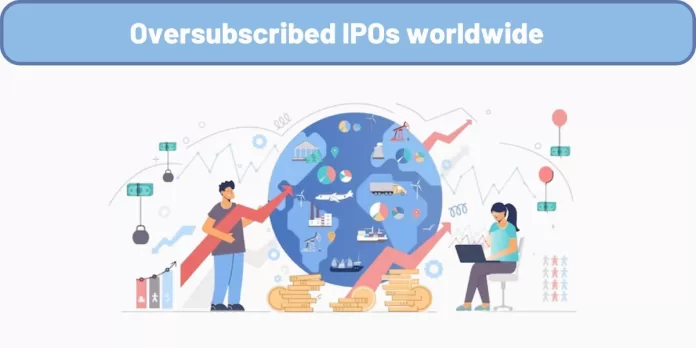IPO oversubscription, also referred to as overallocation in the context of an initial public offering, occurs when the demand for shares surpasses the number of shares available for purchase. To illustrate, consider an electric vehicle (EV) company preparing for its IPO, which experienced an astonishing oversubscription of 300 times, indicating that 30,000 potential investors were interested in every 100 shares offered by the company.
This occurrence of IPO oversubscription stems from heightened investor interest in the shares of a newly introduced company, resulting in an excess of capital being offered beyond what the company originally intended to accept.
Various factors contribute to the phenomenon of IPO oversubscription. When a company makes the decision to go public, a critical aspect of the IPO process is determining the size of the offering, which significantly influences investor participation and the capital raised.
Oversubscription typically occurs when one segment of an IPO, be it institutional or retail investors, receives more applications than there are shares available for allocation. This surplus demand tends to drive the share price higher, often exceeding the company’s net asset value.
Investors in an IPO can be categorized into three main groups: Qualified Institutional Buyers (QIBs), Non-Institutional Buyers (NIIs), and Retail Investors.
Read: IPO Categories in India
The primary drivers of IPO oversubscription stem from the practice of companies designating specific share allotments for each category of investors. When there is an excess of applications seeking shares compared to the available allocation in a particular category, it results in the issue becoming oversubscribed.
Companies initiate IPOs with the goal of raising capital from the market. An oversubscribed IPO allows the company to secure more funds through market mechanisms than it could through conventional borrowing from banks or financial institutions. As a consequence, it enables companies to list their shares at premium prices, potentially delivering superior returns to investors.
Here are the Top Oversubscribed IPOs Country wise:
- Lyft (Nasdaq, US 2019): The Lyft IPO was 20 times oversubscribed, which prompted the company to raise its stock price and increase the number of shares on offer. The company priced the stock at $72 for the listing, which was at the upper end of the targeted price range of USD 70–72. The stock popped up more than 20% on its market debut. The listing helped the Google-backed ride-hailing company raise more than USD 2.3 billion. However, the honeymoon for Lyft stock was short-lived.
- Suzhou HYC Technology (Shanghai Stock Exchange, China 2019):
As the pioneering company to launch an IPO on the new Star Market of the Shanghai Stock Exchange, witnessed an extraordinary level of oversubscription for its shares. These shares were subscribed 335.6 times, demonstrating a high level of investor enthusiasm, even in the face of certain criticisms related to its prospectus. At the time, the company announced its initial public offering price at 24.26 yuan per share, which valued it at a considerable 41 times its 2018 earnings. Excluding bids below the final IPO price, the oversubscription was still notably high at 257.6 times. - Latent View Analytics Limited (NSE, India 2021)
The Latent View Analytics IPO experienced an extraordinary level of oversubscription at 326.49 times. This IPO was structured as a book-built issue with a total value of Rs 600.00 crores. The offering consisted of a fresh issue amounting to Rs 474.00 crore and an offer for sale totalling Rs 126 crore. The shares were officially listed on the BSE and NSE on November 23, 2021. The pricing range for the Latent View Analytics IPO was established at Rs 190 to Rs 197 per share. The minimum application lot size comprised 76 shares, with a corresponding minimum investment requirement of Rs 14,972 for retail investors.Furthermore, within this IPO, there was a specific allocation of up to 350,877 shares set aside for employees, available at a discounted rate of Rs 19 relative to the issue price. - Tadawool Group (Saudi Stock Exchange, Saudi 2021): Saudi Tadawul Group Holding Co.’s retail offering witnessed an astonishing oversubscription, with total orders amounting to SAR 5.02 billion. The retail tranche of Tadawul’s initial public offering (IPO) was oversubscribed by a remarkable 442.53 times. This surge in demand, equivalent to approximately $1.3 billion, highlighted the strong investor interest in the stock exchange group.Tadawul group had allocated 10.8 million shares, constituting 30% of the total offer shares, to individual investors. These shares were made available at a final price of SR105 per share. During the subscription period that commenced on November 30, approximately 598,327 subscribers participated in the IPO. The lead manager, financial advisor, book-runner, global coordinator, and underwriter, SNB Capital, in conjunction with JP Morgan Saudi Arabia and Citigroup Saudi Arabia, the financial advisors, book-runners, global coordinators, and underwriters of the IPO, made the announcement regarding this robust demand from individual subscribers.
Conclusion
Oversubscribed IPOs around the world are a testament to the strong investor interest in promising companies. Whether it’s Lyft’s rapid rise in the U.S., Suzhou HYC’s groundbreaking IPO in China, or the remarkable responses to Latent View Analytics and Tadawul Group in India and Saudi Arabia, these cases highlight the universal appeal of IPOs.
Read: Cracking The Code Of IPO Allotment
The oversubscription of IPOs reflects both investor confidence and companies’ effective capital-raising strategies. Companies that allocate shares to specific investor categories can attract a diverse range of backers.
In a world where innovation and emerging technologies continue to transform industries, IPOs remain a compelling opportunity for investors to join the growth stories of pioneering companies. However, due diligence and expert advice are essential when navigating the dynamic IPO landscape.
Disclaimer: This blog has been written exclusively for educational purposes. The securities mentioned are only examples and not recommendations. It is based on several secondary sources on the internet and is subject to changes. Please consult an expert before making related decisions.


